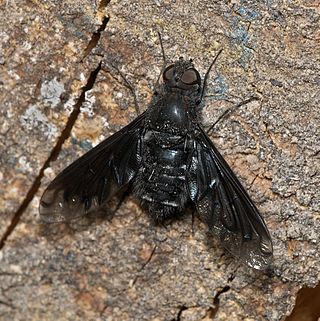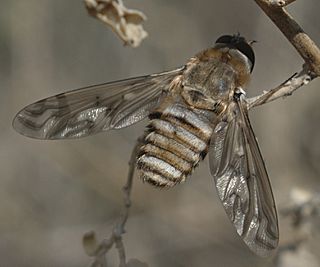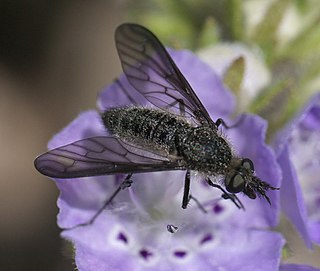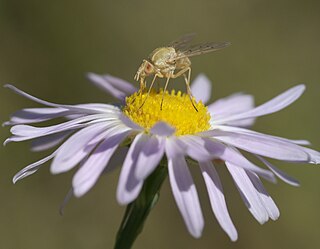
The Bombyliidae are a family of flies, commonly known as bee flies. Some are colloquially known as bomber flies. Adults generally feed on nectar and pollen, some being important pollinators. Larvae are mostly parasitoids of other insects.

Anthrax is a genus of bombyliid flies, commonly known as "bee-flies" due to their resemblance to bees. Most are dull black flies, and are usually small to medium in size, 4–20 millimetres (0.2–0.8 in), and many species have striking wing patterns.

Villa is a genus of flies belonging to the bee-fly family (Bombyliidae). They range in size from 5 to 17 millimetres, and have typically rounded heads. The males of some species have a brilliant mat of silvery patagial scales. About 270 Villa species are found on all continents except Antarctica.

Hemipenthes is a large genus of flies belonging to the family Bombyliidae (bee-flies). There are many described species, distributed throughout the Holarctic realm. These are small to large robust flies with a body length of 5–14 mm. A number of species formerly in this genus were moved to a separate genus, Ins in 2020.

Poecilanthrax is a large, primarily Nearctic genus of flies belonging to the family Bombyliidae.

Anthracinae is a subfamily of bee flies in the family Bombyliidae. There are more than 80 genera and 2,000 described species in Anthracinae.

Bombyliinae is a subfamily of bee flies in the family Bombyliidae. There are more than 70 genera in Bombyliinae.

Systropus is a genus of bee flies in the family Bombyliidae. There are over 200 described species in the genus Systropus, found on every continent except Antarctica.

Thyridanthrax is a genus of bee flies in the family Bombyliidae. There are about 50 described species in the genus Thyridanthrax, found across Eurasia, Africa, North America, and South America.
Aphoebantus is a genus of bee flies. There are at least 80 described species in Aphoebantus.

Lordotus is a North American genus of bee flies in the family Bombyliidae. There are about 30 described species in Lordotus.

Poecilognathus is a North and South American genus of bee flies in the family Bombyliidae. There are about 13 described species in Poecilognathus.

Villini is a tribe of bee flies in the family Bombyliidae.

Thevenetimyia is a genus of bee flies in the family Bombyliidae. There are more than 40 described species in Thevenetimyia found worldwide, mostly in North America with several species in Australia and southeast Asia.
Pantarbes is a genus of bee flies in the family Bombyliidae. There are six described species in Pantarbes.
Paracosmus is a North American genus of bee flies in the family Bombyliidae. There are five described species in Paracosmus.
Tmemophlebia is a North and South American genus of bee flies in the family Bombyliidae. There are about 17 described species in Tmemophlebia.
Rhynchanthrax is a North American genus of bee flies in the family Bombyliidae. There are seven described species in Rhynchanthrax.
Lepidanthrax arnaudi is a species of bee fly in the family Bombyliidae. It is found in California.

Neacreotrichus is a genus of bee flies in the family Bombyliidae. There are about 13 described species in Neacreotrichus, found in the United States and Mexico.















